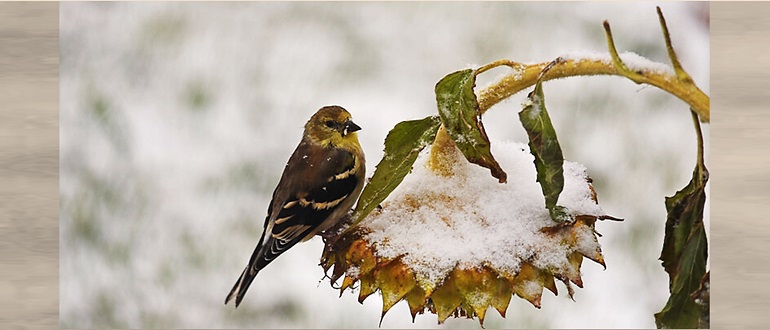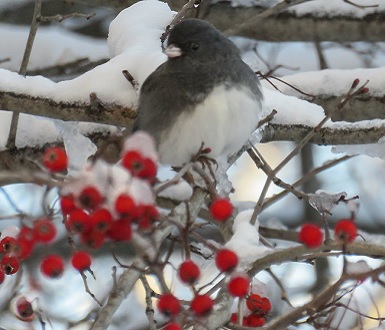American goldfinch on a snow covered sunflower head – public domain
Finding Joy and Beauty in Winter’s Cold
On a cold, wintry day – when summer’s flowers are but a faded memory – winter gardens may seem a bit sad and lonely. Without the lushness of green foliage, the brilliance of pretty flowers, and the happiness of fluttery friends, it sometimes feels that the color, the life, and the joy of the garden have all drained away. Sigh… It makes a gardener dream of spring.
FUN FACT: There are approximately 70 species of sunflowers, and all are native to North America. Each individual sunflower bloom may contain as many as 2,000 seeds for hungry finches (and other feathered friends). Growing giant sunflowers is a bit of a sport, and the current champion (in the Guinness Book of Records) reached 30 ft 1 in tall and was grown in Karst, Germany in 2014. For pictures see GUINNESS
Yet, every good habitat gardener knows that gardens are very much alive, and working hard, throughout the cold and snowy season. Winter is a lovely time to dream of pretty blooms to come; but as we pull out our seed catalogs and write-up our wish lists, let us also take time to appreciate the garden in winter.
Of course, our backyard bird feeders attract an army of hungry visitors – both feathered friends and a good number of fat and happy squirrels! But it is the garden’s complement of native shrubs that provides an overall frame and structure while also providing wind breaks, cover and resting sites for wildlife. Even well into winter’s dreary days, some shrubs (and trees) may retain a few persistent fruits for wildlife.
Red-osier dogwoods, winterberry, maple-leaf viburnum, sumac, and nannyberry are a few examples of Michigan native shrubs that offer late season, persistent fruits which hang on branches long after ripening. Such fruits are loaded with nutrition and generally have high a fat content that is especially important for winter wildlife.
Any garden lucky enough to include the brilliant red branches of a Red-osier dogwood may also be lucky enough to shelter a chrysalis of a spring azure butterfly. The larvae of these small and pretty butterflies survive winter’s freezing temperatures by staying safely hidden in the layers of leaf litter left under the shrub.
Likewise, cocoons of “hummingbird” clearwing moths may be sheltered in leaf litter under a plum tree or snowberry shrub. And, throughout the watershed, the larval stages of many pollinating insects (and other good bugs) are resting now – buried in protective layers of leaf litter found under the dried stalks and stems of appropriate host plants. Though hidden from sight, most tiny of creatures are a promise of new life for spring!
Even dried stalks, leaves and seed heads, that have been left along a garden path, offer a palette of color, contrast, and structure when set against a snowfall. Such garden debris may appear dead – and rather messy – to the human eye, but it serves the needs of wildlife by offering cover, shelter and bits of wintertime food for small mammals, birds and insects that happen by. Perhaps a bumblebee queen is sleeping in the dirt under a favorite perennial or a solitary carpenter bee rests in his nest. Amazingly, a winter garden may even shelter and protect a full-grown mourning cloak butterfly.
For these large and handsome butterflies survive Michigan winters in adult form. They literally freeze and thaw with ambient temperatures while hiding in the smallest of cracks and crevices. The hardiest of all butterflies, these beautiful creatures are even occasionally spotted flying above the snow on a sunny day as definitive proof of life in the winter garden.
Meanwhile, our rain gardens are not just for April showers and summer storms. No, these hard-working gardens continue to protect our rivers and streams through the coldest season by collecting snow melt. In winter, rain gardens help filter rock salt and chemical deicers before such contaminants can run-off into our waterways. (The picture at right was taken at the parking lot of Plymouth’s PARC building. Snow melt can be seen – as a dark patch – trickling onto the the drainage pad and then melting the snow in the center of the rain garden.)
So this winter season, on some cold and snowy day, let us look for the unique and special beauty of our winter garden and celebrate the color, life and joy to be found.
A NEW YEAR’S MESSAGE FROM FOTR
We, at Friends of the Rouge, thank you for planting, and tending to, your habitat gardens. We appreciate all that you do throughout the year to create and protect valuable habitat for our native creatures. We also thank our community of volunteers for the many, many hours of planting, watering, weeding, pulling, hauling, counting, measuring, and monitoring. Your efforts do make a difference. And so, on behalf of all the:
– frogs, toads, and turtles;
— ducks, geese, and herons;
—– Mayflies, dragonflies, and butterflies;
——- hummingbirds, blue jays, and sparrows;
——— foxes, raccoons, and opossums;
———– and even a special, one-eared squirrel named Gilligan,
Categories
-
News & EventsLearn more about upcoming FOTR events and projects







